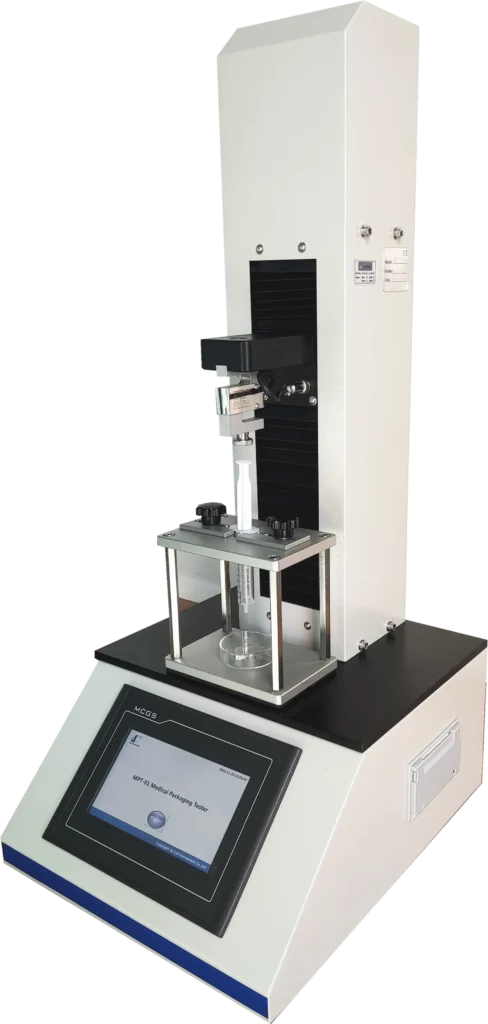Luer Cone Breakage Resistance
ISO 11040-4 Annex C2
In syringe manufacturing and quality control, one of the most critical mechanical assessments is the luer cone breakage resistance test. The structural integrity of the syringe front end, especially the luer cone, directly impacts both patient safety and device reliability. To ensure consistent, standardized evaluation, the ISO 11040-4 standard—specifically Annex C2—outlines the procedures and requirements for conducting this test. This article will walk you through the testing process, essential equipment, and data interpretation needed to comply with ISO 11040-4 testing standards.
Importance of Luer Cone Breakage Resistance
The luer cone, located at the front end of the syringe barrel, is a potential weak point prone to mechanical stress during handling, assembly, or injection. Luer cone breakage resistance testing helps determine how much force the cone can withstand before fracturing. For manufacturers of pre-filled syringes and glass barrels for injectables, this test is not just a regulatory requirement—it’s a fundamental quality control measure to avoid failures in medical applications.
ISO 11040-4 Annex C2 Luer Cone Breakage Resistance Test Method
The ISO 11040-4 standard, titled Prefilled Syringes — Part 4: Glass barrels for injectables and sterilized subassembled syringes ready for filling, includes Annex C2, which details the front end breakage resistance test. This section outlines the conditions under which the test must be performed, including apparatus requirements, specimen handling, testing procedures, and result documentation.
Key Testing Conditions Include:
- Test speed: 25 mm/min
- Application point: 2 mm from the syringe tip
- Minimum sampling rate: 500 Hz for peak measurement accuracy
- Force applied until glass breakage occurs
Following this guidance ensures that your syringe testing processes remain traceable, reproducible, and compliant.
Syringe Tester for ISO 11040-4 Annex C2 Testing
To accurately perform luer cone breakage resistance tests, you’ll need a reliable and precise universal tensile and compression testing machine. The apparatus must meet these ISO 11040-4 Annex C2 requirements:
- A load cell suitable for measuring breakage forces
- An accurate, programmable test speed control
- A custom stainless steel holder and loading rod
- Adapter sets matching your syringe design geometry
Recommended Syringe Tester
Cell Instruments’ Syringe Tester is designed to meet the rigorous requirements of ISO syringe testing. Equipped with programmable PLC control, precision mechanics, and customizable fixtures, the MPT-01 provides high-resolution force and displacement data, making it ideal for luer cone breakage resistance assessments. The integrated microprinter and optional RS232 data export also support detailed documentation.
Luer Cone Breakage Resistance Testing Procedure

1. Test Preparation
- Inspect all adapters and materials for damage or compatibility.
- Mount the required adapter and fixtures on the Syringe Tester.
- Ensure proper alignment and install safety guards.
2. Testing Execution
- Insert the syringe barrel into the holder.
- Position the loading pin 2 mm from the syringe tip.
- Set the speed to 25 mm/min and start the test.
- Apply compression until the luer cone fractures.
- Record the maximum force at breakage.

3. Post-Test Clean-Up and Analysis
- Carefully remove the broken syringe.
- Clean the adapter to remove any glass debris.
- Analyze results and confirm fracture location at the front end.
Result Reporting Requirements Under ISO 11040-4
Each test must be documented thoroughly, including the following data:
- Test speed in mm/min
- Distance from the syringe tip at which the force was applied
- Maximum breakage force in newtons (N)
- Sample quantity
- Any anomalies or deviations from the procedure
This level of detail ensures consistency and enables traceability, especially when validating new syringe designs or performing routine quality checks.
Why Choose Cell Instruments for Syringe Testing?
With decades of experience in medical device material testing, Cell Instruments offers state-of-the-art testing solutions tailored to ISO and ASTM standards. Our Syringe Tester is specifically engineered to support a variety of syringe testing methods, including luer cone breakage resistance. Whether you are in production, research, or third-party verification, Cell Instruments can provide customized solutions, automation integration, and comprehensive support to meet your testing needs.
Performing luer cone breakage resistance tests in accordance with ISO 11040-4 Annex C2 is essential for ensuring the mechanical integrity of syringe components. By using accurate equipment like the Syringe Tester, and following the ISO-mandated procedure step-by-step, you can confidently verify product quality, maintain regulatory compliance, and protect patient safety.
Looking for syringe testing solutions that comply with ISO 11040-4?
Contact Cell Instruments Co., Ltd. today for expert guidance and tailored testing systems for your syringe quality assurance needs.